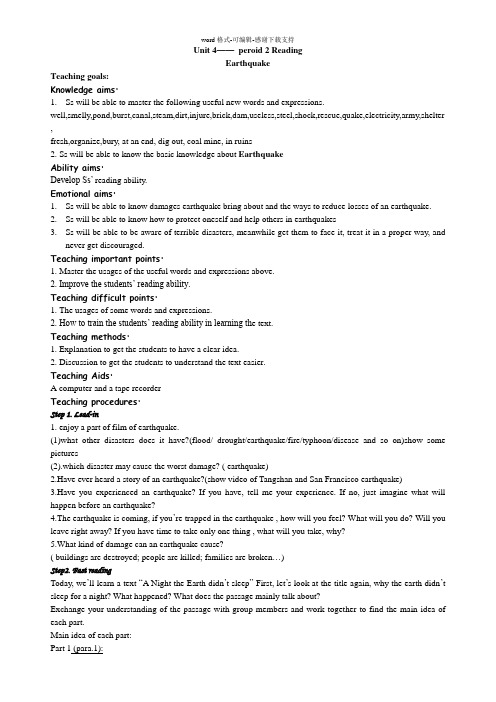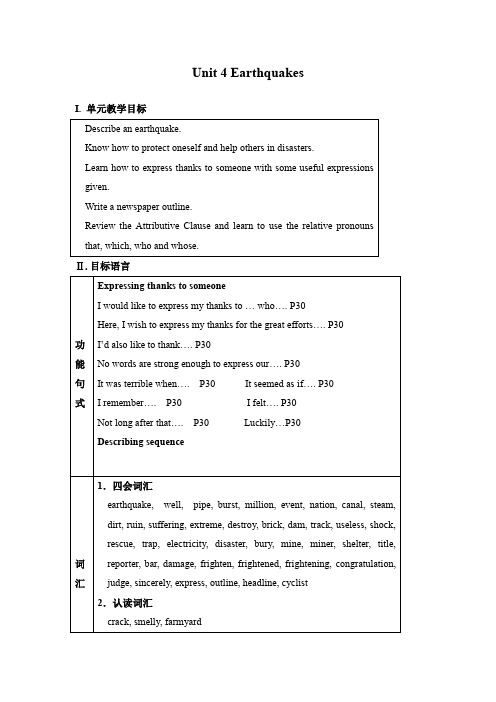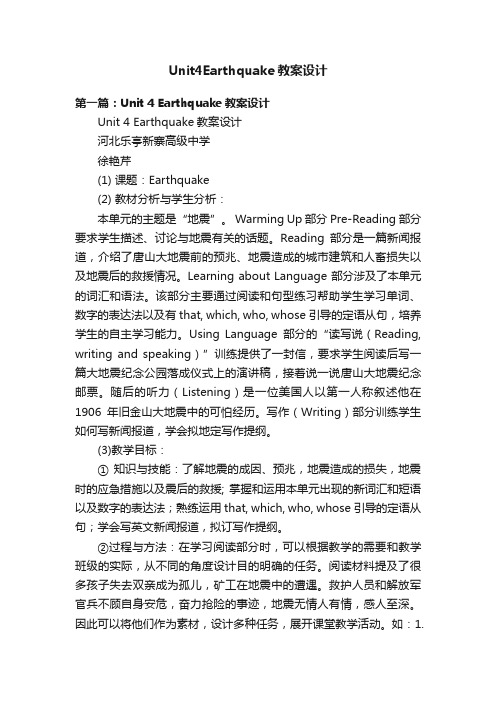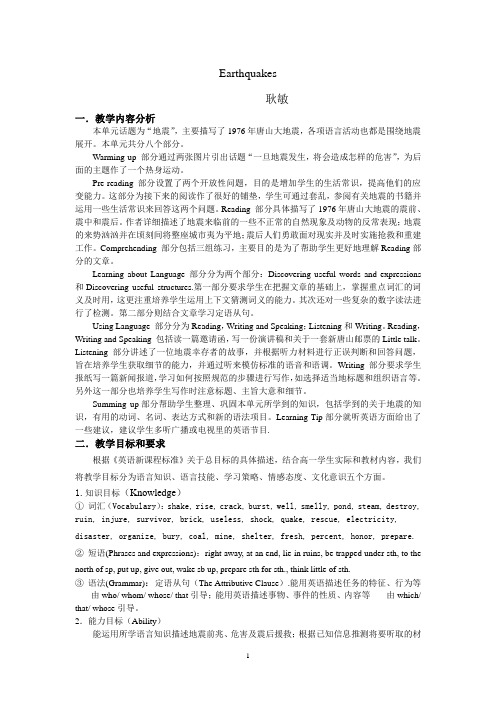unit4Earthquake全单元教案
unit4.-earthquake教案

Unit 4——peroid 2 ReadingEarthquakeTeaching goals:Knowledge aims:1.Ss will be able to master the following useful new words and expressions.well,smelly,pond,burst,canal,steam,dirt,injure,brick,dam,useless,steel,shock,rescue,quake,electricity,army,shelter ,fresh,organize,bury, at an end, dig out, coal mine, in ruins2. Ss will be able to know the basic knowledge about EarthquakeAbility aims:Develop Ss’ reading ability.Emotional aims:1.Ss will be able to know damages earthquake bring about and the ways to reduce losses of an earthquake.2.Ss will be able to know how to protect oneself and help others in earthquakes3.Ss will be able to be aware of terrible disasters, meanwhile get them to face it, treat it in a proper way, andnever get discouraged.Teaching important points:1. Master the usages of the useful words and expressions above.2. Improve the students’ reading ability.Teaching difficult points:1. The usages of some words and expressions.2. How to train the students’ reading ability in learning th e text.Teaching methods:1. Explanation to get the students to have a clear idea.2. Discussion to get the students to understand the text easier.Teaching Aids:A computer and a tape recorderTeaching procedures:Step 1. Lead-in1. enjoy a part of film of earthquake.(1)what other disasters does it have?(flood/ drought/earthquake/fire/typhoon/disease and so on)show some pictures(2).which disaster may cause the worst damage? ( earthquake)2.Have ever heard a story of an earthquake?(show video of Tangshan and San Francisco earthquake)3.Have you experienced an earthquake? If you have, tell me your experience. If no, just imagine what will happen before an earthquake?4.The earthquake is coming, if you’re trapped in the earthquake , how will you feel? What will you do? Will you leave right away? If you have time to take only one thing , what will you take, why?5.What kind of damage can an earthquake cause?( buildings are destroyed; people are killed; families are broken…)Step2. Fast readingToday, we’ll learn a text “A Night the Earth didn’t sleep” First, let’s look at the title again, why the earth didn’t sleep for a night? What happened? What does the passage mainly talk about?Exchange your understanding of the passage with group members and work together to find the main idea of each part.Main idea of each part:Part 1 (para.1):Strange things were happening before the earthquake.Part 2 (para.2-3):The disaster happened and caused a lot of loss.Part 3 (para.4): All hope was not lost.Step 3 careful reading1.Read carefully and try to get more information to fill in the blanks.2.Individual work.Part 2:a). Get the students to find some details of this part.Details:1. At 3:42 am, the greatest earthquake of the 20th century began.2. Steam burst from holes in the ground.3. Hard hills of the rock became rivers of dirt.4. Bricks covered the ground like red autumn leaves.5. Two dams and most of the bridges fell.6. The railway tracks were now useless pieces of steel.7. Sand now filled the wells instead of water.8. Water, food, and electricity were hard to get.b). Fill in the blanks with the data❖1/3 of the nation felt the earthquake .❖ A huge crack that was 8 kilometres long and30 metres wide cut across houses.❖In 15 terrible seconds a large city lay in ruins.❖2/3 of the people died or were injured during the earthquake.❖The number of people who were killed or injured reached more than 400,000 .❖All of the city’s hospitals, 75% of its factories and buildings and 90% of its homes were gone.3.Group workPart 3:How were the people helped by the army?*The army organized teams to dig out those who were trapped and to bury the dead.*Miners were rescued from the coal mines.*Shelters were built for survivors whose homes had been destroyed.*Fresh water was taken to the city.Let the groups have a discussion with their partners about more ways to help the people in the earthquake.Step 4. Post-readingTrue or False1. There were one million people in Tangshan at that time. T2. The earthquake began 10 kilometres directly below the city. F3. Not only the people but also the animals were shocked greatly. T4. There was only one quake at that time. F5. Before the earthquake there wasn’t any thing strange happening. F6. Workers rescued most of the 10,000 coal miners to the south of the city. F7.Almost everything in Tangshan was destroyed. TStep 5 Discussions.What shall we do or not do if an earthquake happens?Dos Don’t s1. Stay in a small room, such 1. Be close to the outside wallas kitchen or bathroom2. Hide under the table or 2. Stay on the balconybed, if you haven’t timeto escape , you may stand 3. Jump out of the tall buildingsclose to the inside wall withsome things covering on the 4. Use the lifthead.3. If you stay in the open air ,keep off the tall building,and go to the fields without trees .Step 6 SummarySeveral days before July 28, 1976, many strange things happened in Tangshan. They were signs for the earthquake. At 3:42 am that day, the earth began to shake, which destroyed the city. Later that afternoon, another big earthquake struck Tangshan. More people were killed or injured and more buildings fell down. Soldiers were called in to help the rescue workers. Teams were organized to dig out the trapped and bury the deadStep 7 homework1.Surf the internet to find more information about earthquakes.2.Finish the “learning about language”part on page 27.Step 8 reflection。
人教版高中英语必修第一册 《Unit 4:Earthquakes》教案

人教版高中英语必修第一册 《Unit 4:Earthquakes》教案一、教学目标1.知识目标o学生能够掌握与地震相关的重点词汇和短语,如 “earthquake, ruin, destroy, rescue, shock” 等。
o学生能够理解并运用描述地震现象、危害和救援的句型和表达方式。
2.技能目标o学生能够听懂有关地震的简单对话和新闻报道,获取关键信息。
o学生能够阅读并理解关于地震的文章,分析文章结构和主旨。
o学生能够用英语简单讲述地震的相关知识和个人应对地震的措施。
o学生能够写一篇关于地震预防或救援的短文,表达自己的观点和建议。
3.情感目标o培养学生对自然灾害的认识和防范意识。
o激发学生的同情心和社会责任感,关注地震受灾地区和人群。
二、教学重难点1.教学重点o重点词汇和短语的记忆与运用。
o对课文中地震相关内容的理解和语言表达的学习。
o培养学生用英语描述地震和表达应对措施的能力。
2.教学难点o如何帮助学生理解地震的复杂科学原理和巨大危害,并能用英语进行准确描述。
o引导学生在写作中清晰、有条理地阐述地震预防或救援的观点和建议。
三、教学方法1.直观演示法:通过图片、视频等展示地震的场景和数据。
2.问题引导法:以问题为导向,引导学生思考和探究。
3.讨论交流法:组织学生讨论地震相关话题,促进学生之间的思想交流。
四、教学过程(一)导入(5 分钟)1.播放一段地震的视频片段,展示地震的破坏力。
2.提问学生:What do you see in the video? How do you feel about earthquakes?(二)词汇学习(10 分钟)1.呈现本单元的重点词汇和短语,结合地震的情景进行讲解。
2.通过词汇练习,如填空、选择等,巩固学生对词汇的理解和掌握。
(三)阅读前准备(5 分钟)1.让学生观察课文标题和图片,预测文章的主要内容。
2.提出一些引导性问题,如:What might the article talk about earthquakes?(四)课文阅读(15 分钟)1.学生快速阅读课文,概括文章的主旨。
【人教版】2019年秋季高中英语必修一Unit 4 Earthquakes 教案

Unit 4 Earthquakes I.单元教学目标Ⅱ.目标语言Ⅲ. 教材分析与教材重组1.教材分析本单元以地震为中心话题,介绍了地震这一自然现象,使大家对地震的起因、前兆、危害及如何在震中自救等有了较全面的了解。
各项语言活动主要围绕这个中心内容对人,事,物进行了描述。
这些练习内容让学生思考如何去避免地震或至少是避免太多的损失。
即对于灾难要有正确的认识,要用积极的态度来对待它。
1.1 Warming-up用唐山和旧金山的两幅图片导入本单元,旨在让学生运用有关知识去描述所见图片,并发挥想象力来描述震后这两个城市的情景。
带着疑问去学新知识,来完善自己对地震的认识。
另一方面,它也为学生提供了功能项目、短语词汇、和语法知识方面的练习。
1.2 Pre-reading是Warming-up的延续。
它由对图片的想象转入到经历地震的想象中。
由两个问题组成。
第一个问题其目的是提高学生在危急关头的应变能力,第二个问题旨在培养学生对周围事物的观察能力,并结合图片培养学生运用语言的能力,也对课文内容作了伏笔。
1.3 Reading从内容来看,它包含了地震的方方面面;从功能项目来看,它包含了本单元大部分的词汇和语法内容,为下一步的语言运用做好了准备。
这是一篇新闻报道,记述了唐山地震的前兆,经过,危害及救援工作。
整篇文章语言生动,扣人心弦,能让人感到地震的可怕性,也能感到政府对灾区人民的关怀。
体现出了人类在自然灾害面前的脆弱和战胜困难时体现出来的集体主义精神。
同时也让学生对灾难临头时如何自救等知识有所了解。
1.4 Comprehending是对目标语言的全面练习,也指导了学生的学习方法和步骤。
它要求学生从字、词、句、语段总体上去把握课文内容。
1.5 Learning about language是继Comprehending之后又一指导性练习。
它着重从词的意义、用法和表达法方面对学生学习英语词汇给予了指导。
尤其是对as if句型和定语从句进行了专练。
高中英语必修知识1《Unit 4 Earthquakes》教案人教版

高中英语必修知识1《Unit 4 Earthquakes》教案人教版部分学生在复习时缺乏系统安排和科学计划,或者学习和复习没有个性化特点,导致学习效果不明显。
下面和一起看看有关高中英语必修知识1《Unit 4 Earthquakes》教案人教版。
《Unit 4 Earthquakes》教案1教学准备教学目标掌握住列举的重点单词和句子教学重难点掌握住列举的重点单词和句子并能灵活运用教学过程Ⅰ.重点单词1.________ vi. 爆裂;爆发n. 突然破裂;爆发2.________ n. 事件;大事3.________ n. 废墟;毁灭vt. 毁灭;使破产4.________ adj. 极度的5.________ vt. 破坏;毁坏;消灭6.________ vt. & vi. (使)震惊;震动n. 休克;打击;震惊7.________ n. & vt. 援救;营救8.________ vt. 使陷入困境n. 陷阱;困境9.________ n. 灾难;灾祸10.________ vt. 埋葬;掩埋;隐藏11.________ n. & vt. 损失;损害12.________ n. 裁判员;法官vt. 断定;判断;判决13.________ vt. 损害;伤害→________ n. 伤害;损害→________ adj. 受伤的14.________ n. 电;电流;电学→________ adj. 用电的;带电的→________ adj. 与电有关的;电学的15.________ vt. 使惊吓;吓唬→ ________ adj. 受惊的;受恐吓的→ ________ adj. 令人恐惧的16.____________ n. 祝贺;(复数)贺词→ _____________ vt. 祝贺Ⅱ.重点短语1.a (great) number ________ 许多;大量的2.dig ________ 掘出;发现3.________ an end 结束;终结4.right ________ 立刻;马上5.as ________ 仿佛;好像6.________ ruins 严重受损;破败不堪7.think little ________ 轻视,满不在乎8.tens ________ thousands of 数以万计9.be proud ________ 以……自豪10.judge ________ 从……判断11.be trapped ________ 陷入12.be buried ________ 埋头于13.put ________ shelters 搭建避难所14.get away ________ 离开15.pay attention ________ 注意Ⅲ知识点教案EX.2 On seeing Jay Chow appear on the stage, the audience burst out _________ (cheer).burst with anger/ joy勃然大怒burst n.突然破裂;爆发a burst of laughter一阵笑声2.n. 废墟,遗迹(常用复数形式);毁灭be/lie in ruins成为废墟;严重受损;破败不堪EX.1 All the towns were/lay in _____ (ruin) after the earthquake.vt.毁灭;使破产ruin oneselfruin one’s health/fame/futureEX.2 过量吸烟损害健康,因此你应该戒烟。
Unit4Earthquake教案设计

Unit4Earthquake教案设计第一篇:Unit 4 Earthquake教案设计Unit 4 Earthquake教案设计河北乐亭新寨高级中学徐艳芹(1) 课题:Earthquake(2) 教材分析与学生分析:本单元的主题是“地震”。
Warming Up部分Pre-Reading部分要求学生描述、讨论与地震有关的话题。
Reading部分是一篇新闻报道,介绍了唐山大地震前的预兆、地震造成的城市建筑和人畜损失以及地震后的救援情况。
Learning about Language 部分涉及了本单元的词汇和语法。
该部分主要通过阅读和句型练习帮助学生学习单词、数字的表达法以及有that, which, who, whose引导的定语从句,培养学生的自主学习能力。
Using Language部分的“读写说(Reading, writing and speaking)”训练提供了一封信,要求学生阅读后写一篇大地震纪念公园落成仪式上的演讲稿,接着说一说唐山大地震纪念邮票。
随后的听力(Listening)是一位美国人以第一人称叙述他在1906年旧金山大地震中的可怕经历。
写作(Writing)部分训练学生如何写新闻报道,学会拟地定写作提纲。
(3)教学目标:① 知识与技能:了解地震的成因、预兆,地震造成的损失,地震时的应急措施以及震后的救援; 掌握和运用本单元出现的新词汇和短语以及数字的表达法;熟练运用that, which, who, whose引导的定语从句;学会写英文新闻报道,拟订写作提纲。
②过程与方法:在学习阅读部分时,可以根据教学的需要和教学班级的实际,从不同的角度设计目的明确的任务。
阅读材料提及了很多孩子失去双亲成为孤儿,矿工在地震中的遭遇。
救护人员和解放军官兵不顾自身安危,奋力抢险的事迹,地震无情人有情,感人至深。
因此可以将他们作为素材,设计多种任务,展开课堂教学活动。
如:1.组织学生讨论震后孤儿的安置2. 模拟采访被抢救的矿工。
Unit_4_Earthquakes全单元教案

Earthquakes耿敏一.教学内容分析本单元话题为“地震”,主要描写了1976年唐山大地震,各项语言活动也都是围绕地震展开。
本单元共分八个部分。
Warming-up 部分通过两张图片引出话题“一旦地震发生,将会造成怎样的危害”,为后面的主题作了一个热身运动。
Pre-reading 部分设置了两个开放性问题,目的是增加学生的生活常识,提高他们的应变能力。
这部分为接下来的阅读作了很好的铺垫,学生可通过套乱,参阅有关地震的书籍并运用一些生活常识来回答这两个问题。
Reading 部分具体描写了1976年唐山大地震的震前、震中和震后。
作者详细描述了地震来临前的一些不正常的自然现象及动物的反常表现;地震的来势汹汹并在顷刻间将整座城市夷为平地;震后人们勇敢面对现实并及时实施抢救和重建工作。
Comprehending 部分包括三组练习,主要目的是为了帮助学生更好地理解Reading部分的文章。
Learning about Language 部分分为两个部分:Discovering useful words and expressions 和Discovering useful structures.第一部分要求学生在把握文章的基础上,掌握重点词汇的词义及时用,这更注重培养学生运用上下文猜测词义的能力。
其次还对一些复杂的数字读法进行了检测。
第二部分则结合文章学习定语从句。
Using Language 部分分为Reading,Writing and Speaking;Listening和Writing。
Reading,Writing and Speaking 包括读一篇邀请函,写一份演讲稿和关于一套新唐山邮票的Little talk。
Listening 部分讲述了一位地震幸存者的故事,并根据听力材料进行正误判断和回答问题,旨在培养学生获取细节的能力,并通过听来模仿标准的语音和语调。
Writing部分要求学生报纸写一篇新闻报道,学习如何按照规范的步骤进行写作,如选择适当地标题和组织语言等。
Unit_4_Earthquake_教学设计

高一英语必修一unit4教案、教学设计与反思教学课题SEFC Book I, Unit 4 Earthquake,The first period , A Night the Earth Didn’t Sleep (高一英语上册第四单元第一课时)类型Reading阅读课课时40分钟授课地点341、339班教室教学设计理论依据英语教学是一种交际活动教学,教学过程是交际活动的过程。
要从组织活动入手,不断进行语言实践,使英语课堂逐渐交际化,这样能有效地培养学生运用英语交际的能力,从而提高学生整体的英语水平。
新课标提出:“外语是学习科学文化知识,获取世界各方面信息和进行国际交往的重要工具。
结合新课程标准的要求和本班学生的实际,对教材进行了操作性较强的处理。
教材分析本课主要介绍了1976年唐山大地震,各项语言活动也都是围绕地震展开。
作者详细描述了地震来临前的一些不正常的自然现象及动物的反常表现;地震的来势汹汹并在顷刻间将整座城市夷为平地;震后人们勇敢面对现实并及时实施抢救和重建工作。
学情分析这个年龄段的学生刚从初三转入高一,还不能掌握英语阅读的技巧,因此在教学的过程中注意引导学生运用略读,跳读等阅读技巧,形成初步的阅读策略。
有些同学基础薄弱,运用英语进行交际的能力较差;有些同学则主动学习的动力不够;还有些同学学习比较认真,好胜心强,渴望得到其他人的认可,很在乎别人对他们的看法;部分学生基础较好,会主动配合老师,愿意开口讲。
学生们都极其需要老师对他们的正确引导和鼓励。
因此,设置他们感兴趣的活动,因材施教,才能让他们融入到课堂活动中来。
教学重点1、如何利用略读、查读等阅读技巧。
2、归纳出本文的中心思想,提高英语的综合运用能力。
教学难点1、如何帮助学生运用阅读策略,促进学生自主学习。
2、怎样以阅读的教学为依托,全面训练学生阅读能力。
3、归纳出本文的中心思想,提高英语的综合运用能力。
教学目标1、知识目标:⑴理解文章的大意,并能划分段落及文章结构。
unit4Earthquake全单元教案

Unit4EarthquakeWarming-upTeaching goals:1.Get a general idea of earthquakes and some other natural disasters;2.Train students’ listening ability and try to improve their pronunciation;3.Know the damage that an earthquake and other disasters could bring about and ways to reducethe losses of an earthquake.Teaching important points:Train the students’ listening ability and improve pronunciation.Teaching aids:A tape recorder; the blackboard; CIA课件Teaching procedures:Step1. Lead-in----video of different natural disastersT: Our hometown is a place full of a kind of disasters. What is it?Typhoon, earthquake, hurricane tsunami, flood, tornado, drought…are all called natural disasters.Q. what damage will they bring about?---- everything in ruins/ death/ losses…Step2. Introduction of Earthquakes (Let students get the general idea of earthquake) Q: what do you know about earthquake? What causes quakes and where do they often happen?How to predict an earthquake?Q: How to avoid being hurt?? ----through gamesQ: Have you heard of any land earthquakes?----Two pictures in warming-up: Tangshan Earthquake and San Francisco Earthquake.Q: What do you know about these two earthquakes?Step3: Listening1.Pre-listening----brief introduction of San Francisco EarthquakeQ: When did the quake happen?。
- 1、下载文档前请自行甄别文档内容的完整性,平台不提供额外的编辑、内容补充、找答案等附加服务。
- 2、"仅部分预览"的文档,不可在线预览部分如存在完整性等问题,可反馈申请退款(可完整预览的文档不适用该条件!)。
- 3、如文档侵犯您的权益,请联系客服反馈,我们会尽快为您处理(人工客服工作时间:9:00-18:30)。
Book 1 Unit 4 earthquake 教案一.教学内容分析本单元话题为“地震”,主要描写了1976年唐山大地震,各项语言活动也都是围绕地震展开。
本单元共分八个部分。
Warming-up 部分通过两张图片引出话题“一旦地震发生,将会造成怎样的危害”,为后面的主题作了一个热身运动。
Pre-reading 部分设置了两个开放性问题,目的是增加学生的生活常识,提高他们的应变能力。
这部分为接下来的阅读作了很好的铺垫,学生可通过套乱,参阅有关地震的书籍并运用一些生活常识来回答这两个问题。
Reading 部分具体描写了1976年唐山大地震的震前、震中和震后。
作者详细描述了地震来临前的一些不正常的自然现象及动物的反常表现;地震的来势汹汹并在顷刻间将整座城市夷为平地;震后人们勇敢面对现实并及时实施抢救和重建工作。
Comprehending 部分包括三组练习,主要目的是为了帮助学生更好地理解Reading部分的文章。
Learning about Language 部分分为两个部分:Discovering useful words and expressions 和Discovering useful structures.第一部分要求学生在把握文章的基础上,掌握重点词汇的词义及时用,这更注重培养学生运用上下文猜测词义的能力。
其次还对一些复杂的数字读法进行了检测。
第二部分则结合文章学习定语从句。
Using Language 部分分为Reading,Writing and Speaking;Listening和Writing。
Reading,Writing and Speaking 包括读一篇邀请函,写一份演讲稿和关于一套新唐山邮票的Little talk。
Listening 部分讲述了一位地震幸存者的故事,并根据听力材料进行正误判断和回答问题,旨在培养学生获取细节的能力,并通过听来模仿标准的语音和语调。
Writing部分要求学生报纸写一篇新闻报道,学习如何按照规范的步骤进行写作,如选择适当地标题和组织语言等。
另外这一部分也培养学生写作时注意标题、主旨大意和细节。
Summing up部分帮助学生整理、巩固本单元所学到的知识,包括学到的关于地震的知识,有用的动词、名词、表达方式和新的语法项目。
Learning Tip部分就听英语方面给出了一些建议,建议学生多听广播或电视里的英语节目.二.教学目标和要求根据《英语新课程标准》关于总目标的具体描述,结合高一学生实际和教材内容,我们将教学目标分为语言知识、语言技能、学习策略、情感态度、文化意识五个方面。
1.知识目标(Knowledge)①词汇(Vocabulary):shake, rise, crack, burst, well, smelly, pond, steam, destroy, ruin, injure, survivor, brick, useless, shock, quake, rescue, electricity,disaster, organize, bury, coal, mine, shelter, fresh, percent, honor, prepare.②短语(Phrases and expressions):right away, at an end, lie in ruins, be trapped under sth, to the north of sp, put up, give out, wake sb up, prepare sth for sth., think little of sth.③语法(Grammar):定语从句(The Attributive Clause).能用英语描述任务的特征、行为等---- 由who/ whom/ whose/ that引导;能用英语描述事物、事件的性质、内容等---- 由which/ that/ whose引导。
2.能力目标(Ability)能运用所学语言知识描述地震前兆、危害及震后援救;根据已知信息推测将要听取的材料的内容;提高阅读技能和用英语进行思维、推理、判断的能力;掌握演讲稿的格式及新闻报道的写作步骤和要点。
3. 情感目标Affect学习唐山人民勇敢面对自然灾害,积极进行灾后重建的精神;在教学活动中培养学生合作精神和互助精神。
三.教学重点和难点1重点词汇:injure,survivor, shock, rescue, disaster, fresh, judge, prepare2语法:The Attributive Clause3难点: 运用所学知识表达自己的想法; 较长句子成分的划分及意义的理解; 如何能就课文内容完成一些开放性的话题讨论,能把课文的内容得以延伸与拓展;指导学生通过各种渠道如报纸、杂志、图书馆和网络等资源查找有关素材,培养信息社会收集查找资料的能力。
四.课时安排本单元共分为四个部分,具体课时教师可根据自身教学实践进行适当地安排和调整。
Part1:Warming-up和listening.通过游戏、介绍和VIDEO等手段对地震知识进行适当了解的基础上,引入对San Francisco地震的学习,从而进入听力部分。
Part2:Pre-reading, Reading, Comprehending and Learning about Language.读前的两个问题:第一个问题问学生在危机情况下会带什么,有利于很好的激起学生的兴趣和调动课堂气氛,由此则可过渡到第二个问题对地震前兆的了解,从而自然地引入到对唐山大地震的学习。
在对唐山大地震震前、震中和震后的学习中,可结合今年唐山大地震30周年的报道,使学生进一步了解唐山大地震和现今的唐山,形成对比和强烈的震撼,从而更好地了解学习唐山人民勇敢面对自然灾害,积极进行灾后重建的精神。
其次,通过对文章的学习,了解新闻的特点,为后面的写作做准备。
重点词汇和语法的学习可结合文章进行,并配以适当的练习。
Part3:Writing由提前让学生完成的关于唐山的新闻写作来引入对写作的学习。
通过对学生习作的评析,来引出新闻写作中应注意的事项,并通过适当的练习来进行巩固,再让学生对自身的习作进行修改。
Part4:Using Language(Reading, Writing and Speaking),主要学习SPEECH演讲稿的写作。
通过对演讲稿的了解、注意事项和名人演讲的感受,让学生学会如何恰当地写演讲稿。
五.教学步骤The first period Warming-up & ListeningTeaching goals:Get a general idea of earthquakes and some other natural disasters;Train students’ listening ability and try to improve their pronunciation;Know the damage that an earthquake and other disasters could bring about and ways to reduce the losses of an earthquake.Teaching important points:Train the students’ listening ability and improve pronunciation. Teaching aids:A tape recorder; the blackboard; CIA课件Teaching procedures:Step1. Lead-in----video of different natural disastersT: Our hometown is a place full of a kind of disasters. What is it?Typhoon, earthquake, hurricane tsunami, flood, tornado, drought…are all called natural disasters.Q. what damage will they bring about?---- everything in ruins/ death/ losses…Step2. Introduction of Earthquakes (Let students get the general idea of earthquake)Q: what do you know about earthquake? What causes quakes and where do they often happen? How to predict an earthquake?Q: How to avoid being hurt?? ----through gamesQ: Have you heard of any land earthquakes?----Two pictures in warming-up: Tangshan Earthquake and San Francisco Earthquake.Q: What do you know about these two earthquakes?Step3: ListeningPre-listening----brief introduction of San Francisco EarthquakeQ: When did the quake happen? ---- 1906Q: what damage did bring about?---- About 700 people died in the earthquake and the fires. And as many as 250,000 people lost homes…While-Listening----according to the exercises in the text book3. Post-listening----How can we reduce the damage of earthquake? What can we do?Step4: Homework---- preview the reading “A Night the Earth didn’t Sleep” and learn new words of this unitThe second and the third period ReadingTeaching goals:Target language 目标语言Learn and master the new words and expressions in this period.Ability goals 能力目标Train the students’ reading and speaking ability.Train the students’ ability to use the Internet to search for some useful information.Train the students’ ability to cooperate with others.Teaching important points: Train th e students’ reading ability—skimming and scanning.Teaching difficult points: Describe the disasters. Teaching aids:CIA课件Teaching procedures:Step1. Lead-inT: We have a visit to the museum of natural disasters, and you have learned about some brief introduction of most disasters. Today, I want to show you round the earthquake department, and I hope you will like it and learn some useful knowledge. Now let’s go.T: At the very beginning, I want to know how much you know about an quake.Q1: What would you take with you if a quake happened?Q2: The best way to save yourself is to know there will be a quake before it happens. What kind of signs can tell you that there is a quake?Q3: What kind of damage can an earthquake cause?S: buildings are destroyed; people are killed; families are broken…T: Let’s have a look at some pictures of such terrible site. (Pictures of quakes)T: (The last picture is monument of Tangshan quake.) Do you know what this is?Step2. Pre-ReadingT: 30 years ago, on the day July, the 28th, a terrible disaster suddenly happened, and the beautiful Tangshan was removed from the map. This is Tangshan quake. Does any body know something about Tangshan quake?T: Let’s read a news report about the famous quake.Step3. While-readingI. Skimming & scaringGet the students comprehend the passage quickly and accurately, and meanwhile help the students to form a good habit of reading.T: First please skim the passage fast to obtain/ get a general understanding of the whole passage. And underline the answers to the following questions.Read the passage again and try to get more detailed information.T: Now let’s read the passage again and find more information. Join the correct parts of the sentences. (Turn to page 27, ex1)T: Now you have read the passage carefully, please put the sentences in order. Number each of these things during the Tangshan quake.(Turn to page 27, ex2)T: here are some more work for you. You can work in groups.Or what do you learn from such a disaster?(Self-rescue, environment protection, rebuilt, love and help)I: self-rescue (a video game)T: When in a quake, if you know some self-rescue skills, you may probably save yourself. If you want to know some of the skills, click here. (Link to the index)Let’s do little game to see how much you know about self-rescue.II. What did they suffer and feel?T: Can you understand what they suffer and what they feel after such a disaster?T: If you were one of the rescuers 30 years ago, what could you say and what can you do to comfort them? Or how could you help them?III. RebuildingT: we see that the new Tangshan has been set up. What is needed to rebuild Tangshan.IV: environment protectionT: nowadays there are more disasters than before. One of the reasons is that we pay more attention to our economy development than the earth we live.Look at these pictures. What can we students do to save the earth?T: T hough the disasters destroy buildings, people’s lives, but it can not d estroy the love among us.Step 5 Homework Find more news reports about earthquake.Write a piece of news about Tangshan. You can use the information in the passage.The fourth period Language points and SpeakingTeaching goals:1 语言目标Learn and master the new words and expressions in this period.2 能力目标Train the students’ reading and speaking ability.3.情感目标Train the students’ ability to use the Internet to search for some useful information.Train the students’ ability to cooper ate with others.nguage points :1. In the farmyard, the chickens and even the pigs were too nervous to eat.农家大院里,鸡甚至猪都紧张得不吃东西。
